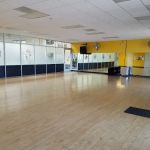
- 1. Why Yoga is Perfect for Beginners
- 2. Getting Started with Yoga: What You Need to Know
- 3. Beginner-Friendly Yoga Poses
- 4. Common Challenges for Beginners and How to Overcome Them
- 5. Setting Realistic Yoga Goals
- 6. Yoga Practice Tips for Newbies
1. Why Yoga is Perfect for Beginners
Yoga is an excellent way to get started with fitness, especially for beginners. Not only does it improve flexibility and strength, but it also helps with stress reduction and mental clarity. The beauty of yoga lies in its adaptability—whether you're young or old, fit or not, yoga can be customized to fit your needs.
For beginners, yoga can be a welcoming and accessible practice. It doesn't require special equipment or high-level skills to start. All you need is a yoga mat, comfortable clothing, and an open mind. Plus, yoga’s focus on mindfulness and breathwork can help you develop a deeper connection with your body, making it an enriching journey beyond just physical exercise.
2. Getting Started with Yoga: What You Need to Know
Starting yoga might feel overwhelming at first, especially with the variety of classes, styles, and resources available. However, by following a few key steps, you can make your entry into yoga a smooth and enjoyable experience:
- Choose the Right Yoga Style: As a beginner, opt for gentle styles such as Hatha or Vinyasa yoga. These styles focus on foundational poses and breathing techniques, making them perfect for newcomers.
- Start with Online Classes or Local Beginner Classes: Many online platforms offer beginner yoga classes that you can follow at your own pace. If you prefer in-person classes, look for beginner-friendly sessions in local yoga studios or gyms.
- Practice Consistency: Like any skill, consistency is key in yoga. Aim for short, regular sessions rather than long, sporadic ones. This will help you gradually build strength and flexibility while staying motivated.
3. Beginner-Friendly Yoga Poses
Yoga poses, or asanas, are the foundation of your practice. Here are some beginner-friendly poses to help you build strength, flexibility, and balance:
- Downward-Facing Dog (Adho Mukha Svanasana): A great full-body stretch that targets the hamstrings, shoulders, and calves, while strengthening your arms and core.
- Child's Pose (Balasana): A restful pose that stretches the back and hips while promoting relaxation. It’s often used as a resting position during more challenging poses.
- Mountain Pose (Tadasana): A simple standing pose that promotes proper alignment and posture. It helps you connect with your breath and prepare for other standing poses.
- Cat-Cow Pose (Marjaryasana-Bitilasana): A dynamic movement that improves spine flexibility, warms up the body, and promotes fluidity in your practice.
- Cobra Pose (Bhujangasana): A gentle backbend that stretches the chest, shoulders, and spine, while improving posture and alleviating back pain.
4. Common Challenges for Beginners and How to Overcome Them
When you first begin your yoga practice, you may face some challenges. Understanding these common obstacles and how to deal with them can help you stay motivated:
- Difficulty with Flexibility: Flexibility is one of the most common challenges for beginners. Remember, yoga isn’t about achieving perfect flexibility overnight. Focus on progress, not perfection. Over time, your flexibility will improve with consistent practice.
- Struggling with Balance: Balance poses can be difficult at first, but practice makes progress. Use props like blocks or a wall to help support your balance as you build strength and coordination.
- Feeling Self-Conscious: Many beginners feel self-conscious in yoga classes. Remember that yoga is a personal journey, and everyone starts somewhere. Focus on your own practice and avoid comparing yourself to others.
5. Setting Realistic Yoga Goals
As a beginner, it’s important to set realistic and achievable yoga goals. Setting goals will help keep you motivated and give you a sense of accomplishment. Here are some goal-setting tips:
- Focus on Consistency: Aim to practice yoga at least 2-3 times per week. Consistency will help you progress and experience the benefits of yoga more fully.
- Celebrate Small Wins: Whether it’s mastering a pose or simply completing a full session without distraction, celebrating your achievements will keep you motivated.
- Set Personal Milestones: For example, setting a goal to hold a pose for a specific amount of time or to learn a new sequence of poses can keep your practice fresh and exciting.
6. Yoga Practice Tips for Newbies
Here are some additional tips to enhance your yoga practice as a beginner:
- Listen to Your Body: Yoga is about connecting with your body. If something feels uncomfortable or painful, back off and adjust your posture or take a break.
- Focus on Your Breath: Breathing is an essential part of yoga. Make sure to breathe deeply and mindfully, as this helps improve focus and relaxation.
- Use Props: Yoga props such as blocks, straps, or blankets can help you modify poses and make them more accessible, especially if you’re still building strength or flexibility.
- Practice Patience: Yoga is a long-term journey. Don’t rush or push yourself too hard. With time, you’ll see improvements both physically and mentally.








 American Barbell Clubs4.0 (196 reviews)
American Barbell Clubs4.0 (196 reviews) Bay Area Boxing5.0 (128 reviews)
Bay Area Boxing5.0 (128 reviews) YMCA Gymnastics Center4.0 (39 reviews)
YMCA Gymnastics Center4.0 (39 reviews) Stretch Pilates and Fitness4.0 (35 reviews)
Stretch Pilates and Fitness4.0 (35 reviews) Planet Fitness4.0 (1056 reviews)
Planet Fitness4.0 (1056 reviews) Crunch Fitness - Norwalk CA3.0 (368 reviews)
Crunch Fitness - Norwalk CA3.0 (368 reviews) Best Strength Exercises for Better Running Economy & Lower Effort This Fall
Best Strength Exercises for Better Running Economy & Lower Effort This Fall 10 Mistakes to Avoid in Workout for Better Results
10 Mistakes to Avoid in Workout for Better Results Why Everyone Should Try Gym Workouts: Health, Fitness, and Motivation
Why Everyone Should Try Gym Workouts: Health, Fitness, and Motivation How to Use Smartwatch Recovery Insights to Decide When to Push and When to Pull Back
How to Use Smartwatch Recovery Insights to Decide When to Push and When to Pull Back The Beginner’s Guide to Olympic Lifts: Safety, Progressions and Sample Workouts
The Beginner’s Guide to Olympic Lifts: Safety, Progressions and Sample Workouts Best Resistance Band Exercises for Shoulder Health and Pulling Strength This Autumn
Best Resistance Band Exercises for Shoulder Health and Pulling Strength This Autumn